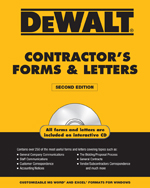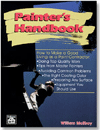
In most industries, franchises have a much higher success rate than independent companies. That’s because franchises leave nothing to chance. Virtually all of their operations represent best practices that have been written into a series of procedures governing everything from “how to keep the books” to “how to greet customers” to “how to perform technical tasks.” That’s why a McDonald’s burger tastes the same, looks the same and is packaged the same whether you buy it from one of its outlets in Seattle or Miami or anywhere in between. It’s a condition of ownership of a McDonald’s franchise that you have to follow their procedures to the letter.
Oh, but your business is as different as night and day from McDonald’s, right? Actually, it’s not as different as you might think.
Any business can benefit from systematizing as many of its procedures as possible. Running a contracting business certainly entails more variables than operating a fast food restaurant, but you also encounter many repetitive tasks in the field and office that can be broken down into step-by-step instructions.
For example, the instructions that follow are drawn from an article I wrote a dozen years ago for Plumbing & Mechanical magazine about OSI, a Long Island-based fuel oil and heating service firm that developed meticulous procedures for hundreds of field and office tasks. The example shown here tells technicians how to perform a routine steam boiler inspection and service. Notice how nothing is left to chance, beginning with ringing the homeowner’s bell and wiping feet before entering.
OSI’S PROPER PROCEDURES FOR A CLEAN AND CHECK
(Preliminary)
Ring bell or knock on door.
Wipe your feet and say, “Good morning or afternoon, Mrs. Jones.”
Try to use back, side or basement doors. Avoid the front door. (Bold face in original document.)
Put down red resin paper if in doubt at all.
Don’t pull out any electrical plugs for freezers, washing machines, dryers, etc., unless necessary and you must leave your truck keys as a reminder by the plug.
Don’t turn off any burner switches on the staircase.
Take low voltage wire off relay or jumper off relay and put into safety.
Open cleanout doors and let the boiler cool off.
(Work begins)
Replace the nozzles.
Steel wool electrodes and take out of the holder and look for cracks.
Check end cone and look down the blast tube.
Clean pump and replace gasket.
Replace oil filter and all gaskets.
Check oil flow on inside tank and clean oil line if necessary.
Clean and check the fan blades.
Oil motors and bearing assemblies (if any).
Clean or replace gauge glass and always replace the washers.
Vacuum and clean the boiler, flue pipe and chimney base. Look outside for a chimney cleanout door.
Install wires back on relay, raise aquastat to start burner.
Start up burner (prime) and take pump pressure, and if two-pipe buried oil tank, take a vacuum test.
Flush low water cutoff and/or feeder while the burner is running. Burner should go off. If not, call office immediately.
Perform a complete CO² test.
Lower the aquastat and clean the boiler jacket.
Clean up around the boiler-burner any rags, speedi-dri, stick-tite, etc., and remove from house.
Keep cleanup tickets in pocket and get them signed.
Check all fittings for oil leaks just before you leave.
Write on your tickets the following information: type of oil burner, name of boiler, if the job has an oil-fired water heater, size and spray pattern of the nozzles.
Don’t knock the last serviceman.
Carrying a binder filled with detailed procedures like this, a new employee can go out and be productive with minimal training in a short period of time. And, this employee will represent the company in a way the owners want it to be represented.
Try to think of certain tasks your company performs over and over that could be detailed in the same way. Think of field operations, the way you handle phone calls and process paperwork, and so on. How many times has your business lost track of customer inquiries or complaints, or misplaced tools or materials, sent out wrong invoices or purchase orders, etc.? These things happen because somebody did something wrong. Maybe they forgot or neglected to follow instructions, or maybe were never taught precisely how to follow through on something.
Often the mistakes become institutionalized. That’s because whoever taught a newcomer to do something may have inadvertently left something out. Think of how many times you’ve told an employee, “Oh, I forgot to tell you about …” The new employee skips that step, after awhile that new employee becomes a veteran who trains a newcomer, and it becomes a case of the blind leading the blind. Maybe the task still gets accomplished, but in a roundabout way that detracts from efficiency.
One of the advantages of a franchise or any business with multiple branches is that they can analyze which of their outlets has the best way of doing something, and adapt that “best practice” to all of their facilities. Best practices also can be obtained from different employees in a single location. Maybe one person has a personal method of performing a task that works better than another person’s way. You’ll want everyone to adopt the best method, and the way to do that is to break it down step-by-step so you don’t have to teach it over and over to new employees-or to existing ones who simply fall back on bad habits.
Think it through, and you, too, probably can identify hundreds of repetitive tasks your field and office people perform day after day that can be broken down into 10 or 20 steps.
Wouldn’t that take a lot of time to analyze and write up?
Yep, it surely will. This is not something to be completed in a day or a week or a month. But if you set your mind to it and make it a goal to produce one or two of these task descriptions every day, within a year or less you could have every relevant task covered, and you would reap the benefits forever. Along the way, the more tasks you have covered, the better off you’ll be. You’ll have to periodically create new descriptions or revise old ones as new products come out and better ways of doing things come to light, but that would entail relatively minor maintenance. Meantime, the lasting benefits include:
Speed up training and productivity of new employees.
Make sure everyone does things the way you want them done.
Helps to track down mistakes due to shortcuts, and holds people accountable.
Lowers your costs due to greater efficiency and fewer mistakes.
Provides a check and balance system for paper flow and communications by making sure everyone receives and signs off on things they are supposed to.
Results in neater, cleaner and more efficient offices and job sites because everything will be in its assigned place.
Instills a sense of teamwork among the staff, who are all working the same way toward common goals.
Frees up time for owners and managers who don’t have to explain things in detail over and over.
Most important, you are likely to have more satisfied customers, because not nearly as many things will go wrong with your services and schedules.
Many construction contractors take an almost perverse pride in operating unsystematically. They associate a systematic approach with paperwork and bureaucracy and prefer to let their gut instincts guide them.
This is OK when you’re a one-man shop. But as soon as you employ even a single assistant you need a way to make sure that other person does things the way you want them done. Don’t let pride and stubbornness get in the way of running a more efficient and profitable business. W&C




Report Abusive Comment